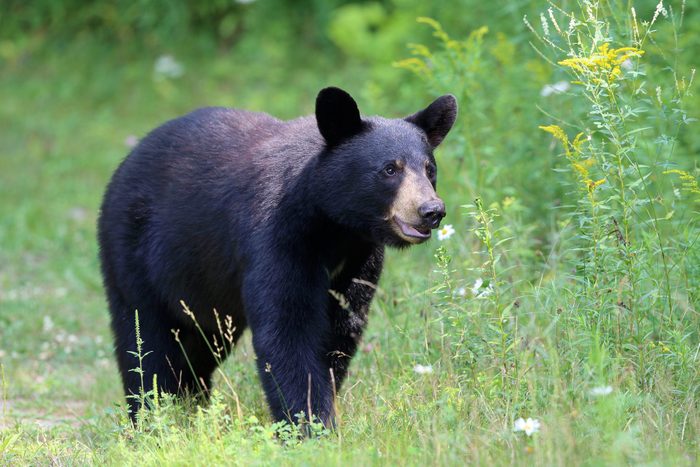Is Your Yard Bear Proof?

Learn what might attract bears to your yard, and how to keep you and them from harm.
One of my earliest memories is of a bear. My family was staying at the Climber’s Ranch in Wyoming’s Teton Mountains. It was night, and from my spot on the front porch I could see a pair of eyes glowing at the edge of the woods.
I was thrilled!
Over the years I’ve had other bear encounters, usually while backpacking. But last month, while on a walk with my mom, I inadvertently came close to a large black bear in, of all places, a neighbor’s yard. I thought it would be scary to see one in town, but the bear was not at all interested in us. It actually felt uplifting to share space with such a large, wild creature.
Regardless, a yard is not a good place for a bear to be. If you’re worried about bears in your yard, here’s what to know.
What Homeowners Should Know About Bears
A bear’s sense of smell is seven times greater than a bloodhound’s, and that sometimes brings them to our yards for an easy snack.
“Being as strong and as smart as they are, this can cause a lot of problems,” says Nicolas Kilby of Think Wild. “However, most conflicts with bears can be easily avoided, as they usually result from improper storage of attractants like garbage, pet food and poultry.”
It’s important to never attract a bear. Once rewarded with easy access to food, it may come back for more.
“Each time this happens, he can become more tolerant of human presence — and this food-conditioning can lead to problematic behavior,” says Lynsey White, director of humane wildlife conflict resolution at the Humane Society of the United States. Besides being dangerous to humans, it often leads to the bear being killed.
Are bears dangerous?
Bears can be dangerous and unpredictable when provoked, but mostly they’re timid animals who rarely attack people. “Although the sight of a black bear can certainly be frightening, most bears run away as soon as they are spotted by a human, and usually even before that,” says White.
What type of bear might come to my yard?
Of the three types of bears in North America, most people are only likely to encounter black bears. They’re in 41 states, thriving everywhere from mountains to forests to deserts to even Florida suburbs. Because grizzly and polar bears are specific to only a couple of regions, this article will focus on black bears.
What do black bears eat?
Bears are opportunistic omnivores. They’ll eat anything that’s an easy meal.
In the wild, a black bear’s diet largely consists of fruits, berries, nuts and other plant matter. In your yard, they might eat garbage, fruit, bird seed, drippings from grills, pet food and chickens.
When am I most likely to find a bear in my yard?
You might see a bear anytime, but evenings and nights in the spring, late summer and fall are more common.
Bears don’t technically hibernate, but they do go into a state of light sleep called torpor. They prepare for this with a feeding frenzy in late summer and fall called hyperphagia, when they consume 20,000 or more calories a day.
Why are black bears beneficial?
Black bears are key contributors to a healthy ecosystem in lots of ways. They disperse seeds across vast distances, even better than birds; break up logs while grubbing, which helps with decomposition and returning nutrients to the soil; and open up forest canopies to allow more sun, allowing greater biological diversity on forest floors.
How To Keep Bears Out of Your Yard
It’s simple: Get rid of anything that might attract them. “No yard is absolutely bear-proof as bears are excellent climbers and swimmers,” White says. “Neither a fence nor a moat will keep them at bay.”
If bears are part of your community, here’s how to make your yard less attractive to them.
- Secure your garbage: This is by far the most effective step. Bring trash cans and recycling inside at night or use bear-resistant containers, like those certified by the Interagency Grizzly Bear Committee.
- Manage your compost: Keep compost as odor-free as possible by turning it frequently and using lime and dry grass clippings to hasten decomposition. Never put meat, fish, oil, grease or dairy products into your compost. If you live in a bear-intensive area, consider skipping composting altogether.
- Rethink your bird feeders: Avoid putting them out from April 1 to November 30. If you do, hang them away from your house and at least 11 feet off of the ground with a thick cable. Switch to sunflower hearts instead of whole seeds and avoid mixes with millet.
- Keep doors and windows locked: Or, if you must lock them open, leave a gap too small for bears to enter.
- Predator-proof your coops: At night, keep chickens in bear-resistant coops. During the day, runs enclosed by electric fencing can protect chickens. “A well-trained guard dog or another guard animal can also be helpful,” says White.
- Protect your beehives and gardens: Electric fencing teaches bears to stay away from food sources, White says. She recommends attaching foil strips to the top wire (at least 24 inches off the ground) and smearing peanut butter or honey on the strips. This will encourage the bear to interact with the fence, giving him a quick jolt and teaching him to stay away.
- Pick fruit before it ripens: Think carefully before planting any new fruit trees. If you already have some, pluck the fruit just before it ripens. And immediately pick up fruit that has fallen to the ground.
- Feed pets indoors: Pet food attracts not only bears, but skunks, raccoons and mice. “The golden rule is to never feed pets outdoors, especially in bear country,” says White. “Doing so trains bears and other wildlife to come to people’s homes for food.”
- Clean your gill: Promptly clean up drippings, move the grill away from your house when not in use, and clean it regularly with ammonia or bleach.
- Never intentionally feed a bear: It encourages encounters and develops behavior that’s dangerous to you and the bear.
What To Do if a Bear Is in Your Yard
Stay calm, stay inside and leave it alone. Attacks by black bears on people are rare, and chances are it will wander away before long.
“If you see a black bear in your yard, don’t fear the worst,” says White. “A youngster may simply be passing through in search of a home of his own. Or an adult may be checking out an enticing smell or interesting sound. Usually, when he finds out there are people around, he’ll head for the hills, never to be seen again.”
You may also scare it away with loud noises. “While this can startle a bear and get it to run away, please make sure you are far away from the bear, or have easy access to a car or home,” says Kilby.
If you’re already outside and cannot safely get to your house:
- Stand and face the bear directly. Never run away from or approach him.
- Make yourself look as big as possible by spreading your arms or, better yet, a coat.
- Make as much noise as possible by yelling, banging pots and pans or other noise-making devices.
- If the bear approaches and you have bear spray, use it. Note: Statistically, bear spray is more effective than firearms. If you live near bears, it’s smart to buy a can of it and know how to safely and properly use it.
- In the rare case that a black bear does attack you, fight back (don’t play dead).
- After the bear leaves, remove whatever attracted him to the location.
Note: These directions are specific for black bears. Here’s what to do in a grizzly bear encounter.



